Income Tax Implications for Business
VerifiedAdded on 2020/03/07
|11
|2598
|99
AI Summary
This assignment examines the income tax implications for a student named Paul operating a business. It focuses on determining the assessable income derived from his business activities according to Section 25(1) of the Income Tax Assessment Act 1936. The analysis incorporates relevant Australian taxation law and regulations, providing a clear understanding of Paul's tax obligations.
Contribute Materials
Your contribution can guide someone’s learning journey. Share your
documents today.
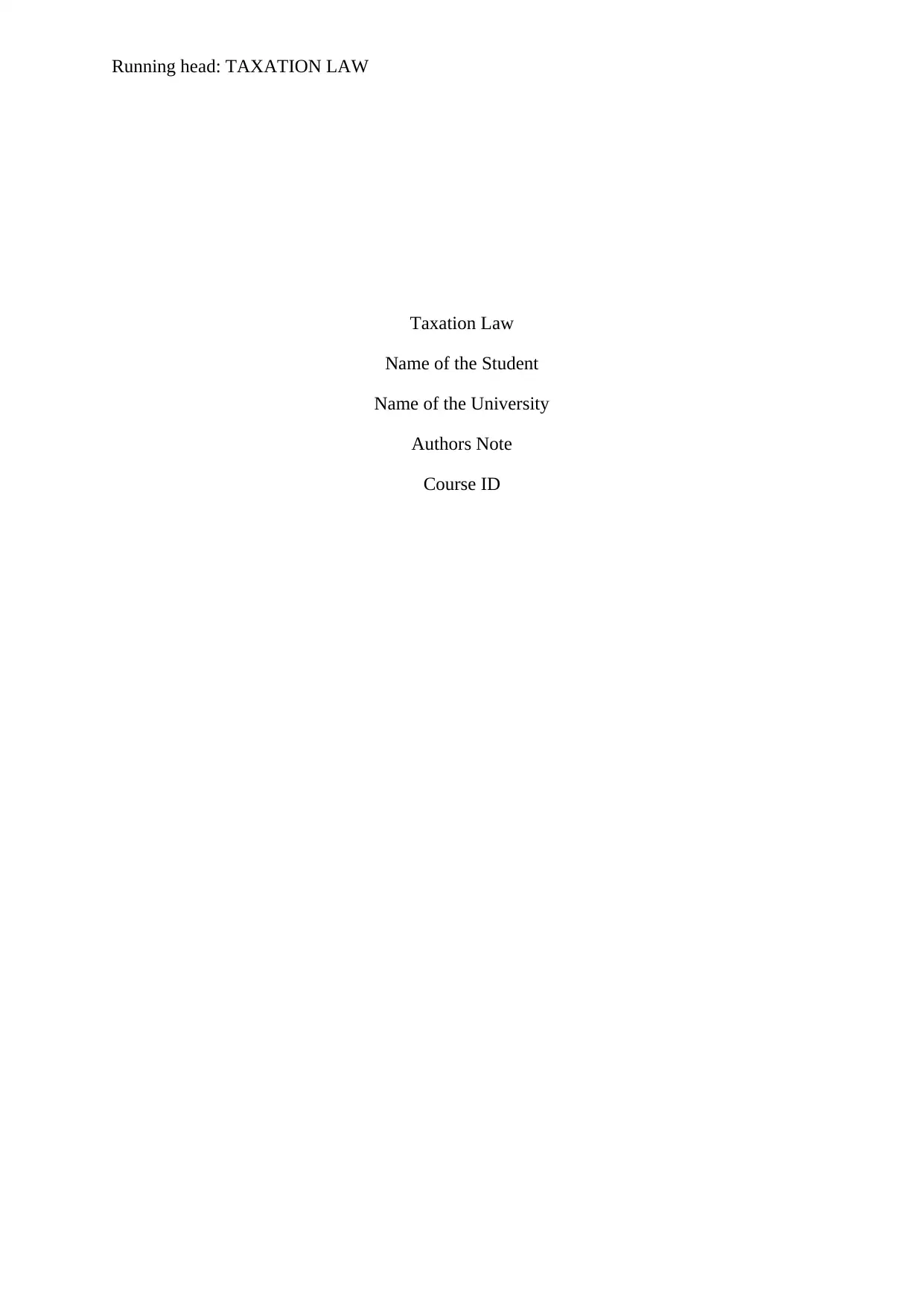
Running head: TAXATION LAW
Taxation Law
Name of the Student
Name of the University
Authors Note
Course ID
Taxation Law
Name of the Student
Name of the University
Authors Note
Course ID
Secure Best Marks with AI Grader
Need help grading? Try our AI Grader for instant feedback on your assignments.
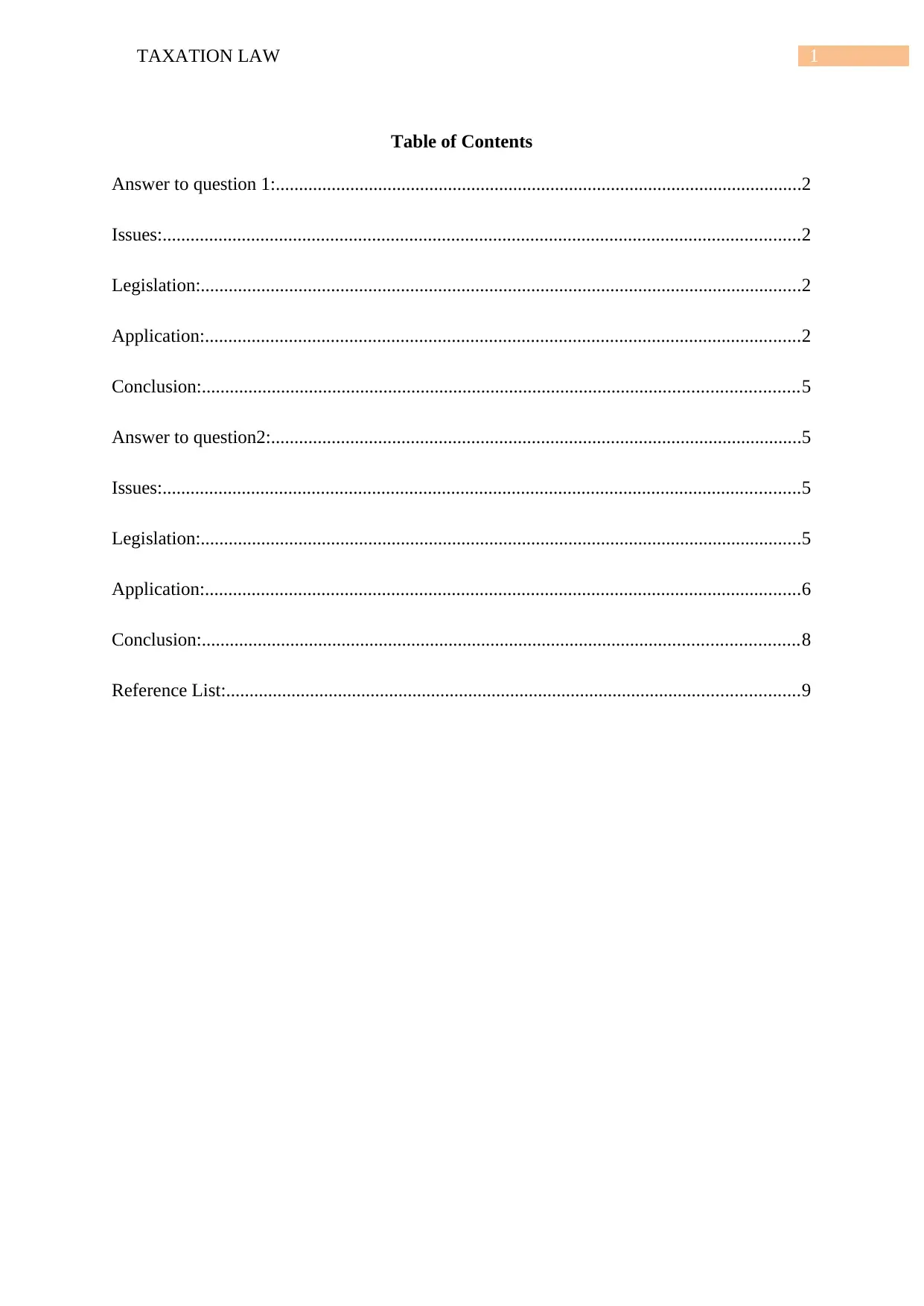
1TAXATION LAW
Table of Contents
Answer to question 1:.................................................................................................................2
Issues:.........................................................................................................................................2
Legislation:.................................................................................................................................2
Application:................................................................................................................................2
Conclusion:................................................................................................................................5
Answer to question2:..................................................................................................................5
Issues:.........................................................................................................................................5
Legislation:.................................................................................................................................5
Application:................................................................................................................................6
Conclusion:................................................................................................................................8
Reference List:...........................................................................................................................9
Table of Contents
Answer to question 1:.................................................................................................................2
Issues:.........................................................................................................................................2
Legislation:.................................................................................................................................2
Application:................................................................................................................................2
Conclusion:................................................................................................................................5
Answer to question2:..................................................................................................................5
Issues:.........................................................................................................................................5
Legislation:.................................................................................................................................5
Application:................................................................................................................................6
Conclusion:................................................................................................................................8
Reference List:...........................................................................................................................9
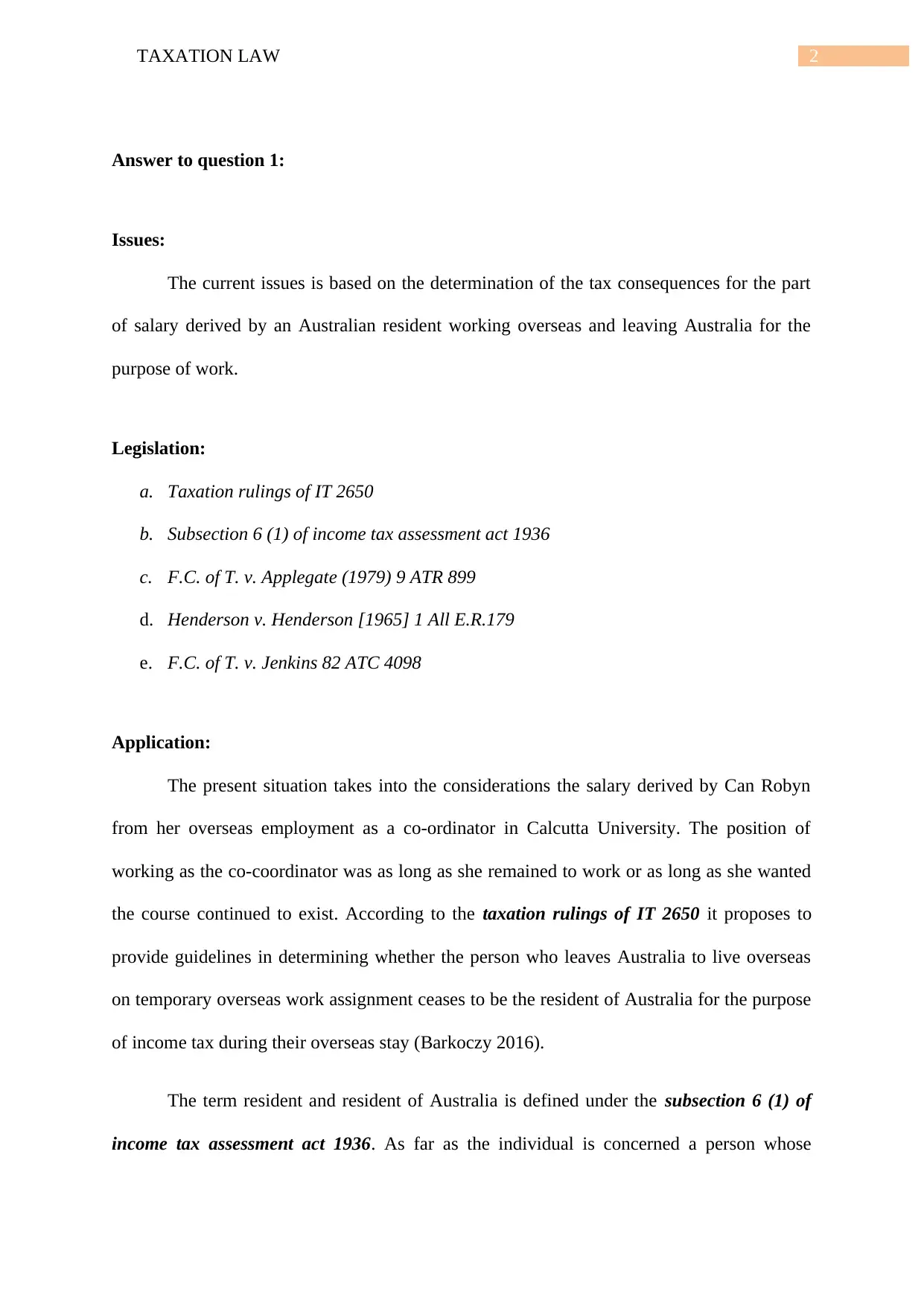
2TAXATION LAW
Answer to question 1:
Issues:
The current issues is based on the determination of the tax consequences for the part
of salary derived by an Australian resident working overseas and leaving Australia for the
purpose of work.
Legislation:
a. Taxation rulings of IT 2650
b. Subsection 6 (1) of income tax assessment act 1936
c. F.C. of T. v. Applegate (1979) 9 ATR 899
d. Henderson v. Henderson [1965] 1 All E.R.179
e. F.C. of T. v. Jenkins 82 ATC 4098
Application:
The present situation takes into the considerations the salary derived by Can Robyn
from her overseas employment as a co-ordinator in Calcutta University. The position of
working as the co-coordinator was as long as she remained to work or as long as she wanted
the course continued to exist. According to the taxation rulings of IT 2650 it proposes to
provide guidelines in determining whether the person who leaves Australia to live overseas
on temporary overseas work assignment ceases to be the resident of Australia for the purpose
of income tax during their overseas stay (Barkoczy 2016).
The term resident and resident of Australia is defined under the subsection 6 (1) of
income tax assessment act 1936. As far as the individual is concerned a person whose
Answer to question 1:
Issues:
The current issues is based on the determination of the tax consequences for the part
of salary derived by an Australian resident working overseas and leaving Australia for the
purpose of work.
Legislation:
a. Taxation rulings of IT 2650
b. Subsection 6 (1) of income tax assessment act 1936
c. F.C. of T. v. Applegate (1979) 9 ATR 899
d. Henderson v. Henderson [1965] 1 All E.R.179
e. F.C. of T. v. Jenkins 82 ATC 4098
Application:
The present situation takes into the considerations the salary derived by Can Robyn
from her overseas employment as a co-ordinator in Calcutta University. The position of
working as the co-coordinator was as long as she remained to work or as long as she wanted
the course continued to exist. According to the taxation rulings of IT 2650 it proposes to
provide guidelines in determining whether the person who leaves Australia to live overseas
on temporary overseas work assignment ceases to be the resident of Australia for the purpose
of income tax during their overseas stay (Barkoczy 2016).
The term resident and resident of Australia is defined under the subsection 6 (1) of
income tax assessment act 1936. As far as the individual is concerned a person whose
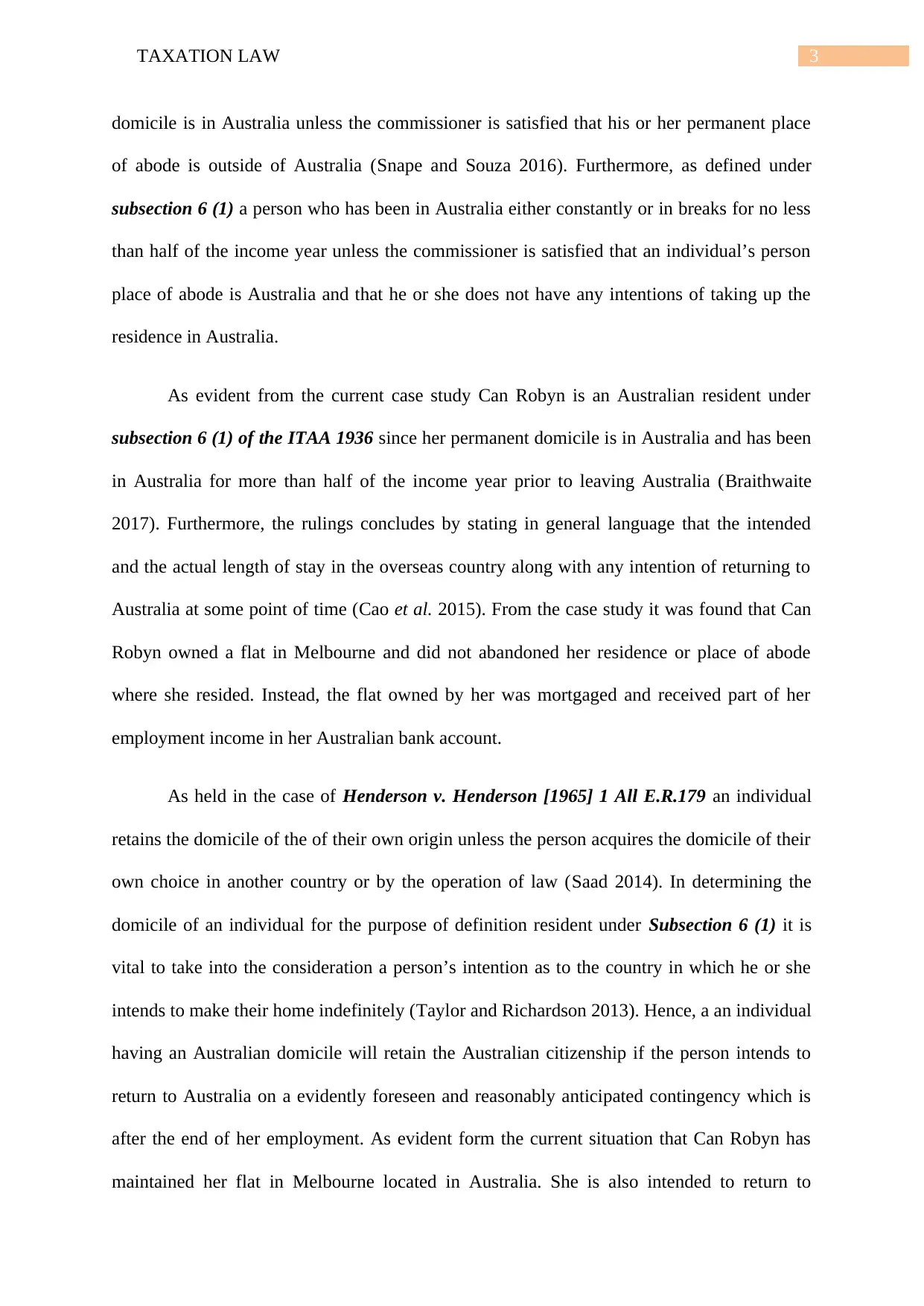
3TAXATION LAW
domicile is in Australia unless the commissioner is satisfied that his or her permanent place
of abode is outside of Australia (Snape and Souza 2016). Furthermore, as defined under
subsection 6 (1) a person who has been in Australia either constantly or in breaks for no less
than half of the income year unless the commissioner is satisfied that an individual’s person
place of abode is Australia and that he or she does not have any intentions of taking up the
residence in Australia.
As evident from the current case study Can Robyn is an Australian resident under
subsection 6 (1) of the ITAA 1936 since her permanent domicile is in Australia and has been
in Australia for more than half of the income year prior to leaving Australia (Braithwaite
2017). Furthermore, the rulings concludes by stating in general language that the intended
and the actual length of stay in the overseas country along with any intention of returning to
Australia at some point of time (Cao et al. 2015). From the case study it was found that Can
Robyn owned a flat in Melbourne and did not abandoned her residence or place of abode
where she resided. Instead, the flat owned by her was mortgaged and received part of her
employment income in her Australian bank account.
As held in the case of Henderson v. Henderson [1965] 1 All E.R.179 an individual
retains the domicile of the of their own origin unless the person acquires the domicile of their
own choice in another country or by the operation of law (Saad 2014). In determining the
domicile of an individual for the purpose of definition resident under Subsection 6 (1) it is
vital to take into the consideration a person’s intention as to the country in which he or she
intends to make their home indefinitely (Taylor and Richardson 2013). Hence, a an individual
having an Australian domicile will retain the Australian citizenship if the person intends to
return to Australia on a evidently foreseen and reasonably anticipated contingency which is
after the end of her employment. As evident form the current situation that Can Robyn has
maintained her flat in Melbourne located in Australia. She is also intended to return to
domicile is in Australia unless the commissioner is satisfied that his or her permanent place
of abode is outside of Australia (Snape and Souza 2016). Furthermore, as defined under
subsection 6 (1) a person who has been in Australia either constantly or in breaks for no less
than half of the income year unless the commissioner is satisfied that an individual’s person
place of abode is Australia and that he or she does not have any intentions of taking up the
residence in Australia.
As evident from the current case study Can Robyn is an Australian resident under
subsection 6 (1) of the ITAA 1936 since her permanent domicile is in Australia and has been
in Australia for more than half of the income year prior to leaving Australia (Braithwaite
2017). Furthermore, the rulings concludes by stating in general language that the intended
and the actual length of stay in the overseas country along with any intention of returning to
Australia at some point of time (Cao et al. 2015). From the case study it was found that Can
Robyn owned a flat in Melbourne and did not abandoned her residence or place of abode
where she resided. Instead, the flat owned by her was mortgaged and received part of her
employment income in her Australian bank account.
As held in the case of Henderson v. Henderson [1965] 1 All E.R.179 an individual
retains the domicile of the of their own origin unless the person acquires the domicile of their
own choice in another country or by the operation of law (Saad 2014). In determining the
domicile of an individual for the purpose of definition resident under Subsection 6 (1) it is
vital to take into the consideration a person’s intention as to the country in which he or she
intends to make their home indefinitely (Taylor and Richardson 2013). Hence, a an individual
having an Australian domicile will retain the Australian citizenship if the person intends to
return to Australia on a evidently foreseen and reasonably anticipated contingency which is
after the end of her employment. As evident form the current situation that Can Robyn has
maintained her flat in Melbourne located in Australia. She is also intended to return to
Secure Best Marks with AI Grader
Need help grading? Try our AI Grader for instant feedback on your assignments.
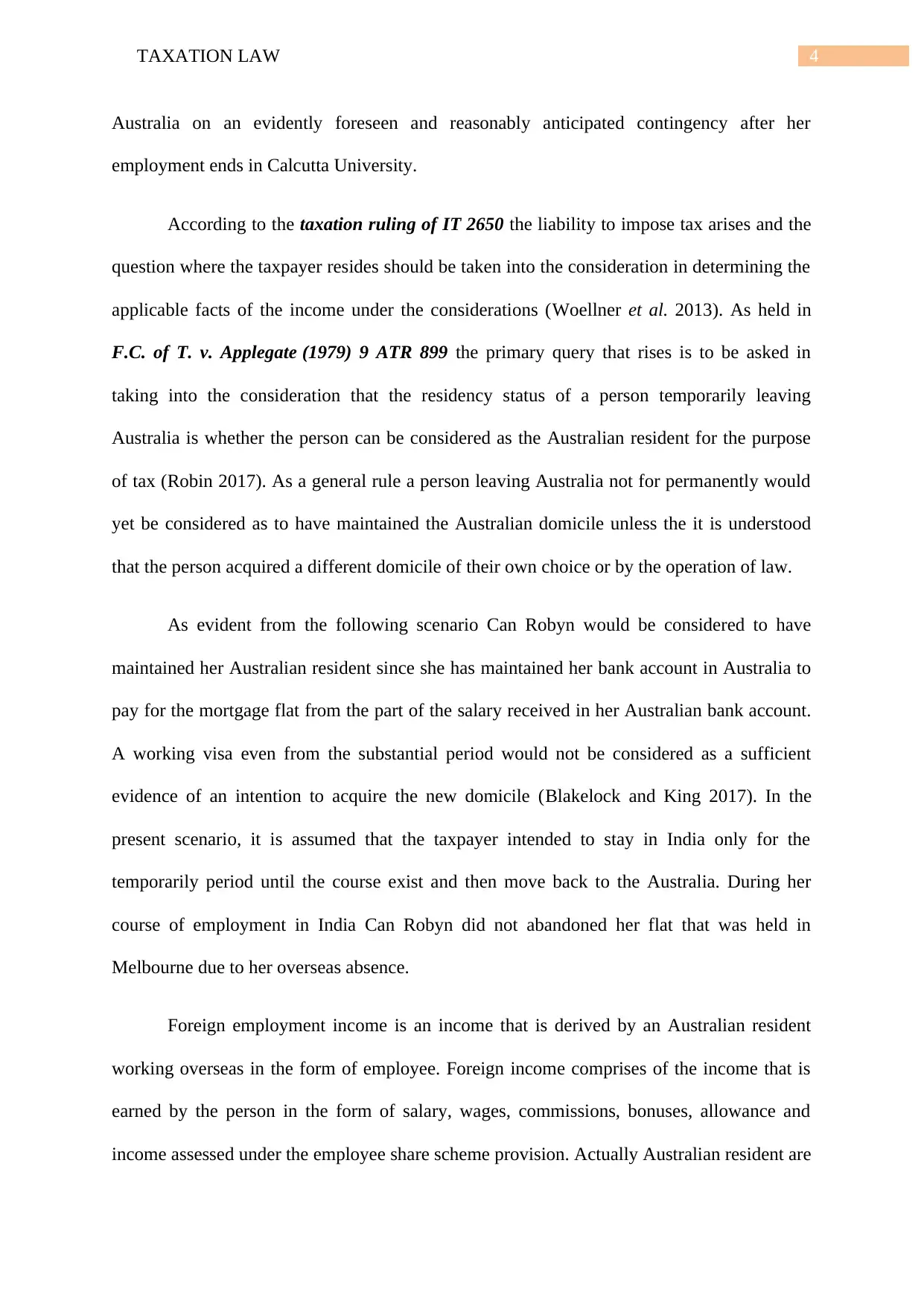
4TAXATION LAW
Australia on an evidently foreseen and reasonably anticipated contingency after her
employment ends in Calcutta University.
According to the taxation ruling of IT 2650 the liability to impose tax arises and the
question where the taxpayer resides should be taken into the consideration in determining the
applicable facts of the income under the considerations (Woellner et al. 2013). As held in
F.C. of T. v. Applegate (1979) 9 ATR 899 the primary query that rises is to be asked in
taking into the consideration that the residency status of a person temporarily leaving
Australia is whether the person can be considered as the Australian resident for the purpose
of tax (Robin 2017). As a general rule a person leaving Australia not for permanently would
yet be considered as to have maintained the Australian domicile unless the it is understood
that the person acquired a different domicile of their own choice or by the operation of law.
As evident from the following scenario Can Robyn would be considered to have
maintained her Australian resident since she has maintained her bank account in Australia to
pay for the mortgage flat from the part of the salary received in her Australian bank account.
A working visa even from the substantial period would not be considered as a sufficient
evidence of an intention to acquire the new domicile (Blakelock and King 2017). In the
present scenario, it is assumed that the taxpayer intended to stay in India only for the
temporarily period until the course exist and then move back to the Australia. During her
course of employment in India Can Robyn did not abandoned her flat that was held in
Melbourne due to her overseas absence.
Foreign employment income is an income that is derived by an Australian resident
working overseas in the form of employee. Foreign income comprises of the income that is
earned by the person in the form of salary, wages, commissions, bonuses, allowance and
income assessed under the employee share scheme provision. Actually Australian resident are
Australia on an evidently foreseen and reasonably anticipated contingency after her
employment ends in Calcutta University.
According to the taxation ruling of IT 2650 the liability to impose tax arises and the
question where the taxpayer resides should be taken into the consideration in determining the
applicable facts of the income under the considerations (Woellner et al. 2013). As held in
F.C. of T. v. Applegate (1979) 9 ATR 899 the primary query that rises is to be asked in
taking into the consideration that the residency status of a person temporarily leaving
Australia is whether the person can be considered as the Australian resident for the purpose
of tax (Robin 2017). As a general rule a person leaving Australia not for permanently would
yet be considered as to have maintained the Australian domicile unless the it is understood
that the person acquired a different domicile of their own choice or by the operation of law.
As evident from the following scenario Can Robyn would be considered to have
maintained her Australian resident since she has maintained her bank account in Australia to
pay for the mortgage flat from the part of the salary received in her Australian bank account.
A working visa even from the substantial period would not be considered as a sufficient
evidence of an intention to acquire the new domicile (Blakelock and King 2017). In the
present scenario, it is assumed that the taxpayer intended to stay in India only for the
temporarily period until the course exist and then move back to the Australia. During her
course of employment in India Can Robyn did not abandoned her flat that was held in
Melbourne due to her overseas absence.
Foreign employment income is an income that is derived by an Australian resident
working overseas in the form of employee. Foreign income comprises of the income that is
earned by the person in the form of salary, wages, commissions, bonuses, allowance and
income assessed under the employee share scheme provision. Actually Australian resident are
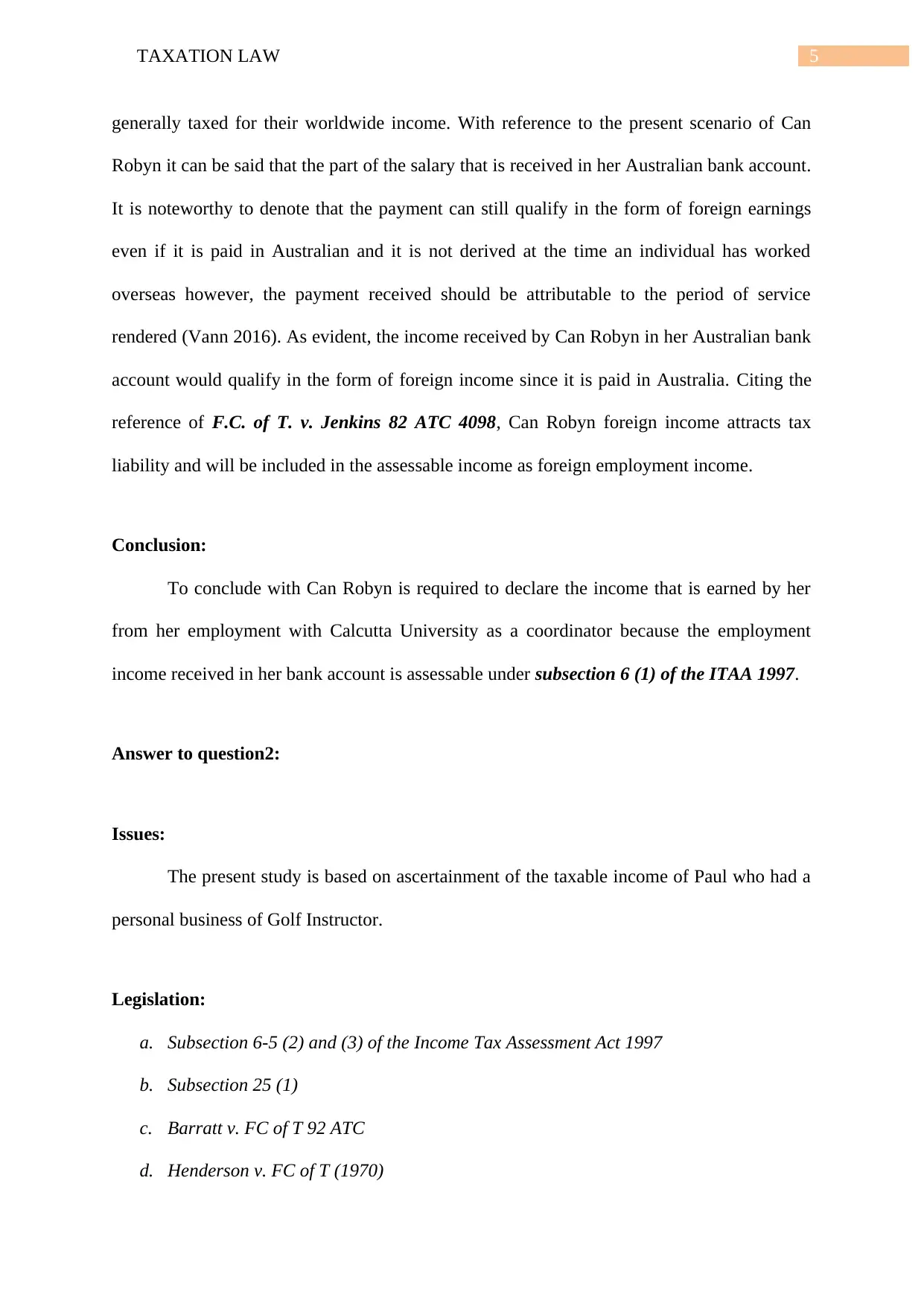
5TAXATION LAW
generally taxed for their worldwide income. With reference to the present scenario of Can
Robyn it can be said that the part of the salary that is received in her Australian bank account.
It is noteworthy to denote that the payment can still qualify in the form of foreign earnings
even if it is paid in Australian and it is not derived at the time an individual has worked
overseas however, the payment received should be attributable to the period of service
rendered (Vann 2016). As evident, the income received by Can Robyn in her Australian bank
account would qualify in the form of foreign income since it is paid in Australia. Citing the
reference of F.C. of T. v. Jenkins 82 ATC 4098, Can Robyn foreign income attracts tax
liability and will be included in the assessable income as foreign employment income.
Conclusion:
To conclude with Can Robyn is required to declare the income that is earned by her
from her employment with Calcutta University as a coordinator because the employment
income received in her bank account is assessable under subsection 6 (1) of the ITAA 1997.
Answer to question2:
Issues:
The present study is based on ascertainment of the taxable income of Paul who had a
personal business of Golf Instructor.
Legislation:
a. Subsection 6-5 (2) and (3) of the Income Tax Assessment Act 1997
b. Subsection 25 (1)
c. Barratt v. FC of T 92 ATC
d. Henderson v. FC of T (1970)
generally taxed for their worldwide income. With reference to the present scenario of Can
Robyn it can be said that the part of the salary that is received in her Australian bank account.
It is noteworthy to denote that the payment can still qualify in the form of foreign earnings
even if it is paid in Australian and it is not derived at the time an individual has worked
overseas however, the payment received should be attributable to the period of service
rendered (Vann 2016). As evident, the income received by Can Robyn in her Australian bank
account would qualify in the form of foreign income since it is paid in Australia. Citing the
reference of F.C. of T. v. Jenkins 82 ATC 4098, Can Robyn foreign income attracts tax
liability and will be included in the assessable income as foreign employment income.
Conclusion:
To conclude with Can Robyn is required to declare the income that is earned by her
from her employment with Calcutta University as a coordinator because the employment
income received in her bank account is assessable under subsection 6 (1) of the ITAA 1997.
Answer to question2:
Issues:
The present study is based on ascertainment of the taxable income of Paul who had a
personal business of Golf Instructor.
Legislation:
a. Subsection 6-5 (2) and (3) of the Income Tax Assessment Act 1997
b. Subsection 25 (1)
c. Barratt v. FC of T 92 ATC
d. Henderson v. FC of T (1970)
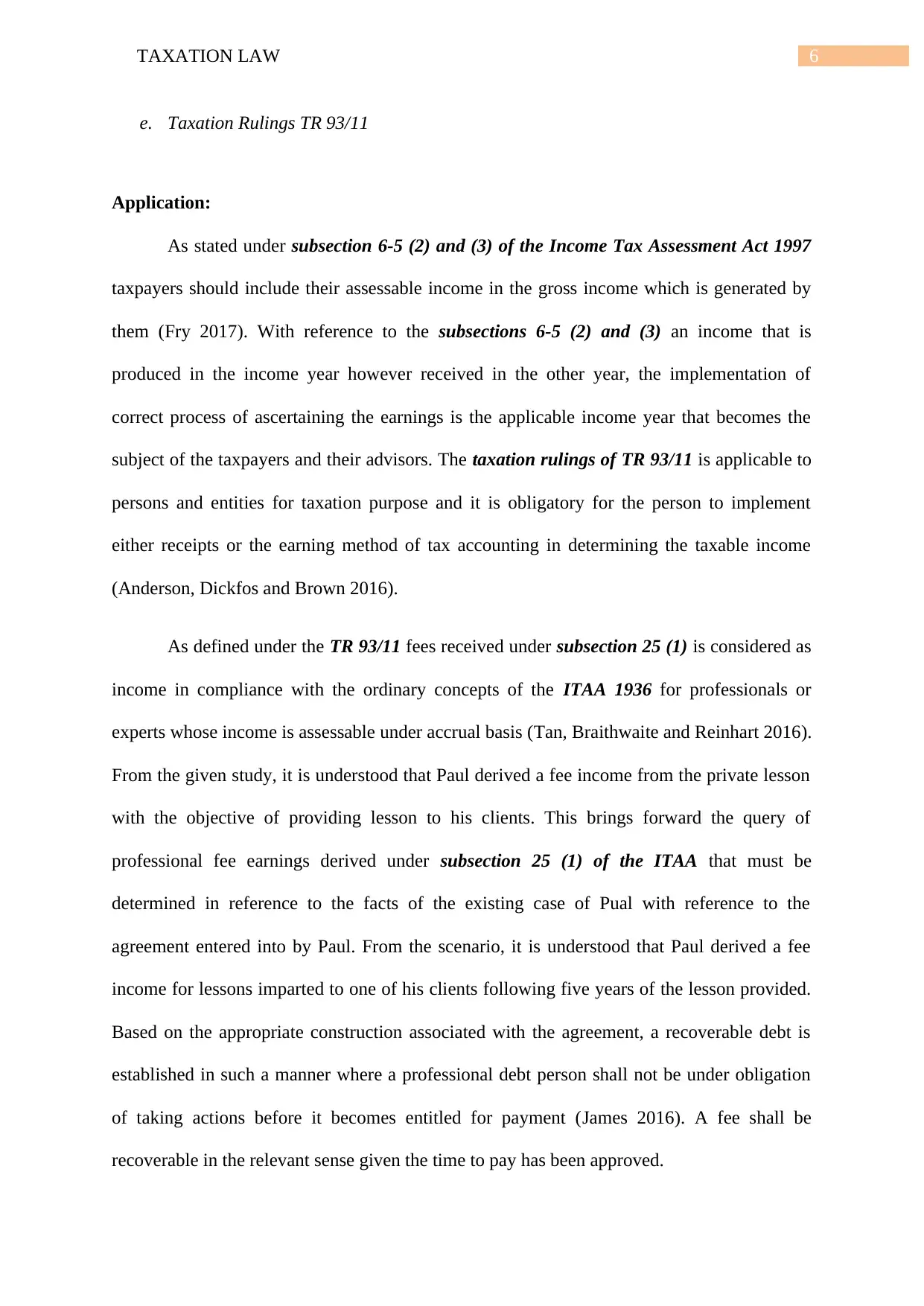
6TAXATION LAW
e. Taxation Rulings TR 93/11
Application:
As stated under subsection 6-5 (2) and (3) of the Income Tax Assessment Act 1997
taxpayers should include their assessable income in the gross income which is generated by
them (Fry 2017). With reference to the subsections 6-5 (2) and (3) an income that is
produced in the income year however received in the other year, the implementation of
correct process of ascertaining the earnings is the applicable income year that becomes the
subject of the taxpayers and their advisors. The taxation rulings of TR 93/11 is applicable to
persons and entities for taxation purpose and it is obligatory for the person to implement
either receipts or the earning method of tax accounting in determining the taxable income
(Anderson, Dickfos and Brown 2016).
As defined under the TR 93/11 fees received under subsection 25 (1) is considered as
income in compliance with the ordinary concepts of the ITAA 1936 for professionals or
experts whose income is assessable under accrual basis (Tan, Braithwaite and Reinhart 2016).
From the given study, it is understood that Paul derived a fee income from the private lesson
with the objective of providing lesson to his clients. This brings forward the query of
professional fee earnings derived under subsection 25 (1) of the ITAA that must be
determined in reference to the facts of the existing case of Pual with reference to the
agreement entered into by Paul. From the scenario, it is understood that Paul derived a fee
income for lessons imparted to one of his clients following five years of the lesson provided.
Based on the appropriate construction associated with the agreement, a recoverable debt is
established in such a manner where a professional debt person shall not be under obligation
of taking actions before it becomes entitled for payment (James 2016). A fee shall be
recoverable in the relevant sense given the time to pay has been approved.
e. Taxation Rulings TR 93/11
Application:
As stated under subsection 6-5 (2) and (3) of the Income Tax Assessment Act 1997
taxpayers should include their assessable income in the gross income which is generated by
them (Fry 2017). With reference to the subsections 6-5 (2) and (3) an income that is
produced in the income year however received in the other year, the implementation of
correct process of ascertaining the earnings is the applicable income year that becomes the
subject of the taxpayers and their advisors. The taxation rulings of TR 93/11 is applicable to
persons and entities for taxation purpose and it is obligatory for the person to implement
either receipts or the earning method of tax accounting in determining the taxable income
(Anderson, Dickfos and Brown 2016).
As defined under the TR 93/11 fees received under subsection 25 (1) is considered as
income in compliance with the ordinary concepts of the ITAA 1936 for professionals or
experts whose income is assessable under accrual basis (Tan, Braithwaite and Reinhart 2016).
From the given study, it is understood that Paul derived a fee income from the private lesson
with the objective of providing lesson to his clients. This brings forward the query of
professional fee earnings derived under subsection 25 (1) of the ITAA that must be
determined in reference to the facts of the existing case of Pual with reference to the
agreement entered into by Paul. From the scenario, it is understood that Paul derived a fee
income for lessons imparted to one of his clients following five years of the lesson provided.
Based on the appropriate construction associated with the agreement, a recoverable debt is
established in such a manner where a professional debt person shall not be under obligation
of taking actions before it becomes entitled for payment (James 2016). A fee shall be
recoverable in the relevant sense given the time to pay has been approved.
Paraphrase This Document
Need a fresh take? Get an instant paraphrase of this document with our AI Paraphraser
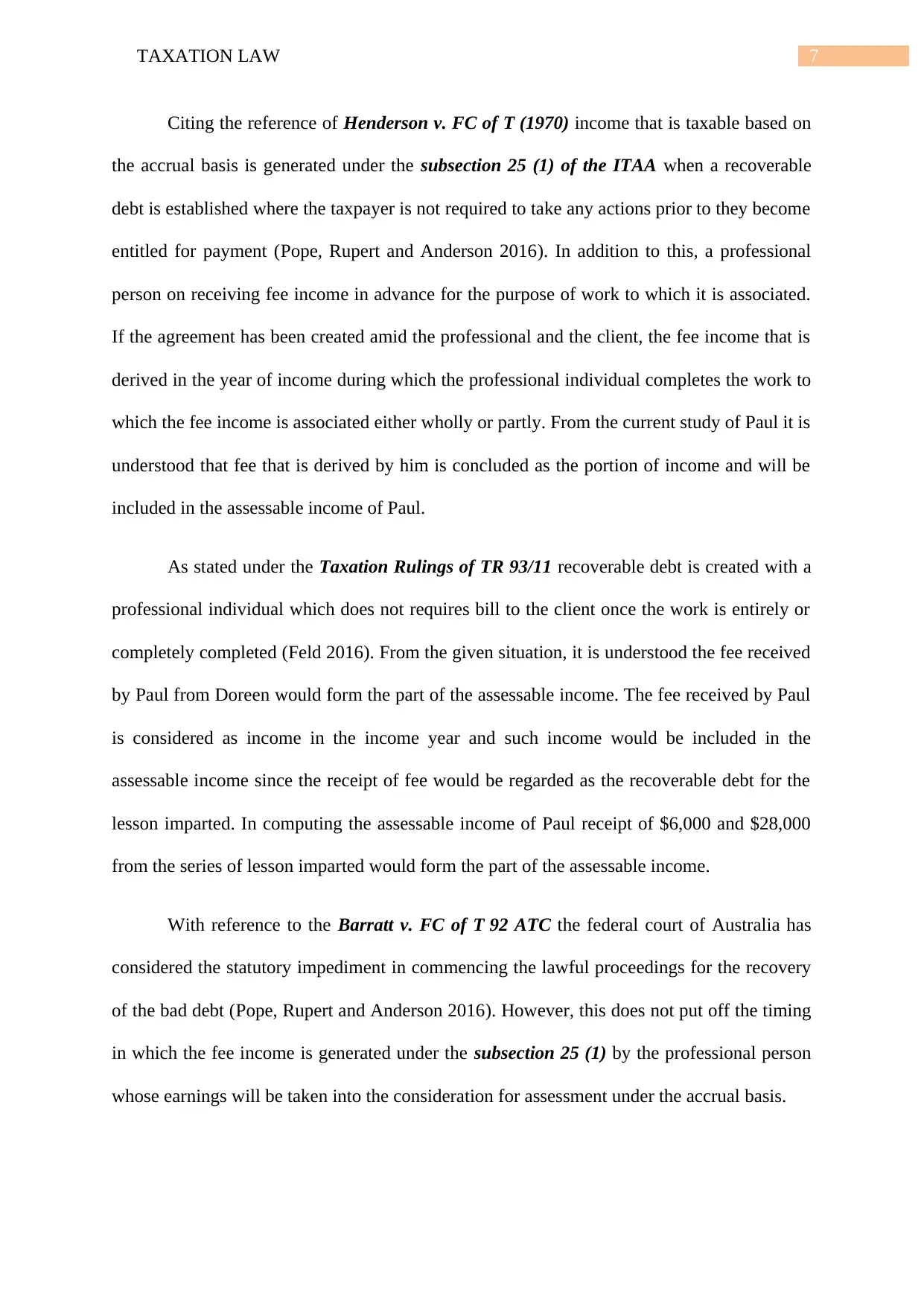
7TAXATION LAW
Citing the reference of Henderson v. FC of T (1970) income that is taxable based on
the accrual basis is generated under the subsection 25 (1) of the ITAA when a recoverable
debt is established where the taxpayer is not required to take any actions prior to they become
entitled for payment (Pope, Rupert and Anderson 2016). In addition to this, a professional
person on receiving fee income in advance for the purpose of work to which it is associated.
If the agreement has been created amid the professional and the client, the fee income that is
derived in the year of income during which the professional individual completes the work to
which the fee income is associated either wholly or partly. From the current study of Paul it is
understood that fee that is derived by him is concluded as the portion of income and will be
included in the assessable income of Paul.
As stated under the Taxation Rulings of TR 93/11 recoverable debt is created with a
professional individual which does not requires bill to the client once the work is entirely or
completely completed (Feld 2016). From the given situation, it is understood the fee received
by Paul from Doreen would form the part of the assessable income. The fee received by Paul
is considered as income in the income year and such income would be included in the
assessable income since the receipt of fee would be regarded as the recoverable debt for the
lesson imparted. In computing the assessable income of Paul receipt of $6,000 and $28,000
from the series of lesson imparted would form the part of the assessable income.
With reference to the Barratt v. FC of T 92 ATC the federal court of Australia has
considered the statutory impediment in commencing the lawful proceedings for the recovery
of the bad debt (Pope, Rupert and Anderson 2016). However, this does not put off the timing
in which the fee income is generated under the subsection 25 (1) by the professional person
whose earnings will be taken into the consideration for assessment under the accrual basis.
Citing the reference of Henderson v. FC of T (1970) income that is taxable based on
the accrual basis is generated under the subsection 25 (1) of the ITAA when a recoverable
debt is established where the taxpayer is not required to take any actions prior to they become
entitled for payment (Pope, Rupert and Anderson 2016). In addition to this, a professional
person on receiving fee income in advance for the purpose of work to which it is associated.
If the agreement has been created amid the professional and the client, the fee income that is
derived in the year of income during which the professional individual completes the work to
which the fee income is associated either wholly or partly. From the current study of Paul it is
understood that fee that is derived by him is concluded as the portion of income and will be
included in the assessable income of Paul.
As stated under the Taxation Rulings of TR 93/11 recoverable debt is created with a
professional individual which does not requires bill to the client once the work is entirely or
completely completed (Feld 2016). From the given situation, it is understood the fee received
by Paul from Doreen would form the part of the assessable income. The fee received by Paul
is considered as income in the income year and such income would be included in the
assessable income since the receipt of fee would be regarded as the recoverable debt for the
lesson imparted. In computing the assessable income of Paul receipt of $6,000 and $28,000
from the series of lesson imparted would form the part of the assessable income.
With reference to the Barratt v. FC of T 92 ATC the federal court of Australia has
considered the statutory impediment in commencing the lawful proceedings for the recovery
of the bad debt (Pope, Rupert and Anderson 2016). However, this does not put off the timing
in which the fee income is generated under the subsection 25 (1) by the professional person
whose earnings will be taken into the consideration for assessment under the accrual basis.
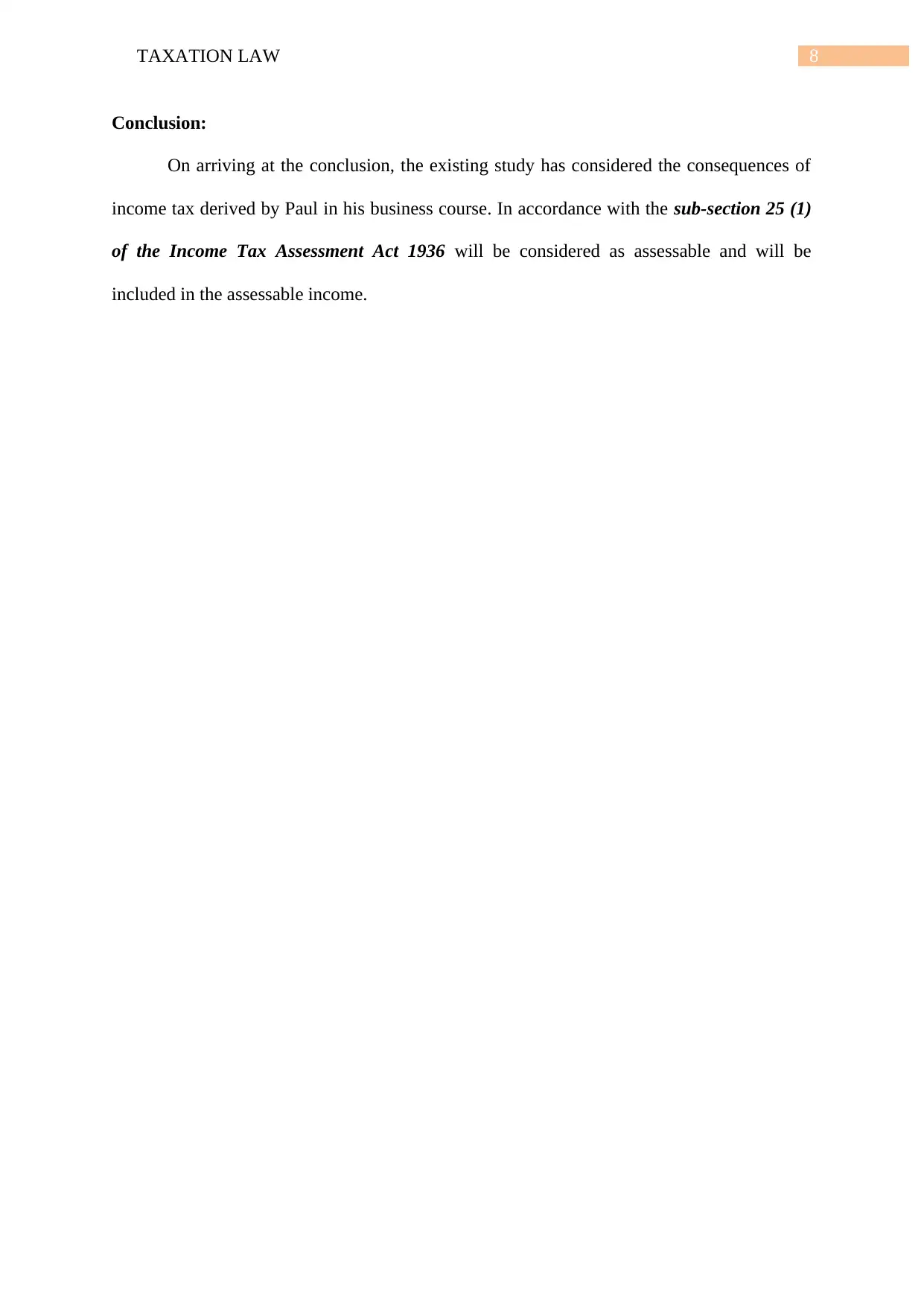
8TAXATION LAW
Conclusion:
On arriving at the conclusion, the existing study has considered the consequences of
income tax derived by Paul in his business course. In accordance with the sub-section 25 (1)
of the Income Tax Assessment Act 1936 will be considered as assessable and will be
included in the assessable income.
Conclusion:
On arriving at the conclusion, the existing study has considered the consequences of
income tax derived by Paul in his business course. In accordance with the sub-section 25 (1)
of the Income Tax Assessment Act 1936 will be considered as assessable and will be
included in the assessable income.
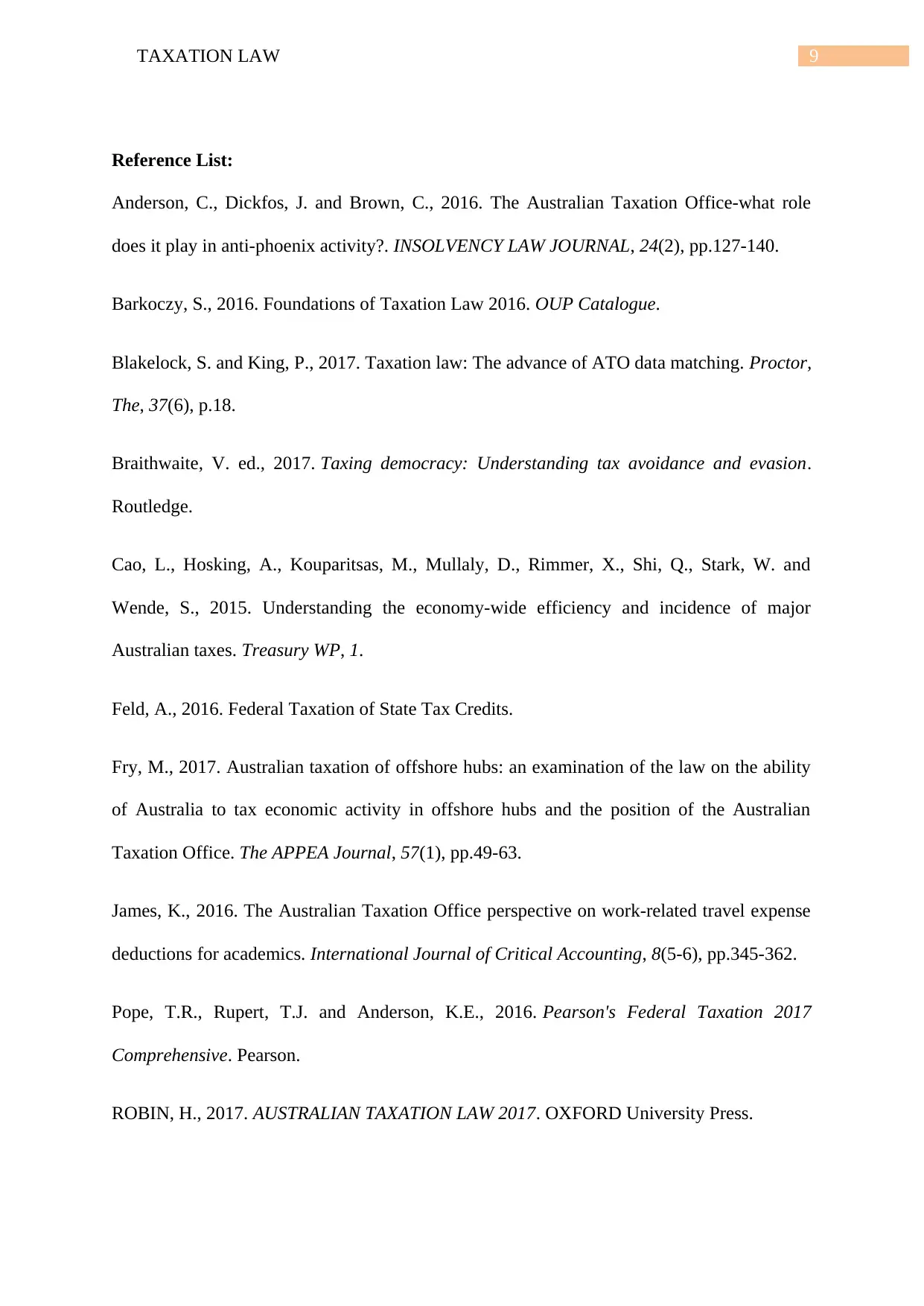
9TAXATION LAW
Reference List:
Anderson, C., Dickfos, J. and Brown, C., 2016. The Australian Taxation Office-what role
does it play in anti-phoenix activity?. INSOLVENCY LAW JOURNAL, 24(2), pp.127-140.
Barkoczy, S., 2016. Foundations of Taxation Law 2016. OUP Catalogue.
Blakelock, S. and King, P., 2017. Taxation law: The advance of ATO data matching. Proctor,
The, 37(6), p.18.
Braithwaite, V. ed., 2017. Taxing democracy: Understanding tax avoidance and evasion.
Routledge.
Cao, L., Hosking, A., Kouparitsas, M., Mullaly, D., Rimmer, X., Shi, Q., Stark, W. and
Wende, S., 2015. Understanding the economy-wide efficiency and incidence of major
Australian taxes. Treasury WP, 1.
Feld, A., 2016. Federal Taxation of State Tax Credits.
Fry, M., 2017. Australian taxation of offshore hubs: an examination of the law on the ability
of Australia to tax economic activity in offshore hubs and the position of the Australian
Taxation Office. The APPEA Journal, 57(1), pp.49-63.
James, K., 2016. The Australian Taxation Office perspective on work-related travel expense
deductions for academics. International Journal of Critical Accounting, 8(5-6), pp.345-362.
Pope, T.R., Rupert, T.J. and Anderson, K.E., 2016. Pearson's Federal Taxation 2017
Comprehensive. Pearson.
ROBIN, H., 2017. AUSTRALIAN TAXATION LAW 2017. OXFORD University Press.
Reference List:
Anderson, C., Dickfos, J. and Brown, C., 2016. The Australian Taxation Office-what role
does it play in anti-phoenix activity?. INSOLVENCY LAW JOURNAL, 24(2), pp.127-140.
Barkoczy, S., 2016. Foundations of Taxation Law 2016. OUP Catalogue.
Blakelock, S. and King, P., 2017. Taxation law: The advance of ATO data matching. Proctor,
The, 37(6), p.18.
Braithwaite, V. ed., 2017. Taxing democracy: Understanding tax avoidance and evasion.
Routledge.
Cao, L., Hosking, A., Kouparitsas, M., Mullaly, D., Rimmer, X., Shi, Q., Stark, W. and
Wende, S., 2015. Understanding the economy-wide efficiency and incidence of major
Australian taxes. Treasury WP, 1.
Feld, A., 2016. Federal Taxation of State Tax Credits.
Fry, M., 2017. Australian taxation of offshore hubs: an examination of the law on the ability
of Australia to tax economic activity in offshore hubs and the position of the Australian
Taxation Office. The APPEA Journal, 57(1), pp.49-63.
James, K., 2016. The Australian Taxation Office perspective on work-related travel expense
deductions for academics. International Journal of Critical Accounting, 8(5-6), pp.345-362.
Pope, T.R., Rupert, T.J. and Anderson, K.E., 2016. Pearson's Federal Taxation 2017
Comprehensive. Pearson.
ROBIN, H., 2017. AUSTRALIAN TAXATION LAW 2017. OXFORD University Press.
Secure Best Marks with AI Grader
Need help grading? Try our AI Grader for instant feedback on your assignments.
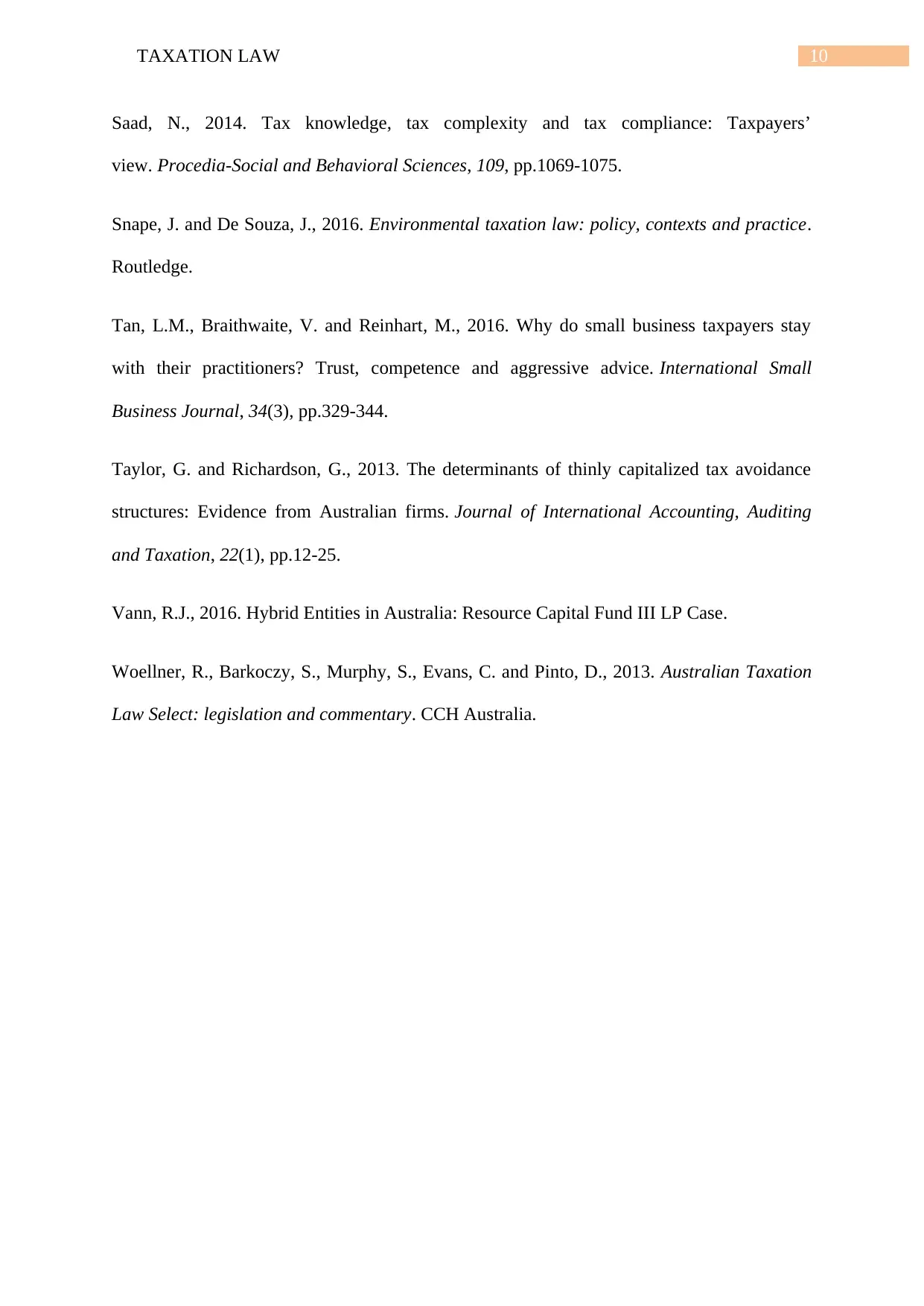
10TAXATION LAW
Saad, N., 2014. Tax knowledge, tax complexity and tax compliance: Taxpayers’
view. Procedia-Social and Behavioral Sciences, 109, pp.1069-1075.
Snape, J. and De Souza, J., 2016. Environmental taxation law: policy, contexts and practice.
Routledge.
Tan, L.M., Braithwaite, V. and Reinhart, M., 2016. Why do small business taxpayers stay
with their practitioners? Trust, competence and aggressive advice. International Small
Business Journal, 34(3), pp.329-344.
Taylor, G. and Richardson, G., 2013. The determinants of thinly capitalized tax avoidance
structures: Evidence from Australian firms. Journal of International Accounting, Auditing
and Taxation, 22(1), pp.12-25.
Vann, R.J., 2016. Hybrid Entities in Australia: Resource Capital Fund III LP Case.
Woellner, R., Barkoczy, S., Murphy, S., Evans, C. and Pinto, D., 2013. Australian Taxation
Law Select: legislation and commentary. CCH Australia.
Saad, N., 2014. Tax knowledge, tax complexity and tax compliance: Taxpayers’
view. Procedia-Social and Behavioral Sciences, 109, pp.1069-1075.
Snape, J. and De Souza, J., 2016. Environmental taxation law: policy, contexts and practice.
Routledge.
Tan, L.M., Braithwaite, V. and Reinhart, M., 2016. Why do small business taxpayers stay
with their practitioners? Trust, competence and aggressive advice. International Small
Business Journal, 34(3), pp.329-344.
Taylor, G. and Richardson, G., 2013. The determinants of thinly capitalized tax avoidance
structures: Evidence from Australian firms. Journal of International Accounting, Auditing
and Taxation, 22(1), pp.12-25.
Vann, R.J., 2016. Hybrid Entities in Australia: Resource Capital Fund III LP Case.
Woellner, R., Barkoczy, S., Murphy, S., Evans, C. and Pinto, D., 2013. Australian Taxation
Law Select: legislation and commentary. CCH Australia.
1 out of 11
Related Documents
Your All-in-One AI-Powered Toolkit for Academic Success.
+13062052269
info@desklib.com
Available 24*7 on WhatsApp / Email
![[object Object]](/_next/static/media/star-bottom.7253800d.svg)
Unlock your academic potential
© 2024 | Zucol Services PVT LTD | All rights reserved.





